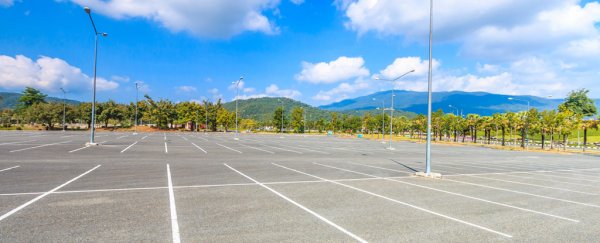We're always being told how self-driving cars will reward us with almost unimaginable benefits when they finally hit the streets. Aside from the sheer convenience of being chauffeured everywhere by artificial intelligence (AI), there's the safety factor of not having error-prone humans behind the wheel, not to mention how environmentally friendly driverless electric vehicles could be.
But there's also another advantage to not driving our own vehicles around, and it's one that could have a vast impact on the look, feel, and function of the cities that we live in: parking. Put simply, if we're not driving our own vehicles to and from destinations any more, we won't need to park idle vehicles on public streets or in car parks – something that could radically change the vibe of congested urban spaces.
"The biggest impact is going to be on parking. We aren't going to need it, definitely not in the places we have it now," Alain L. Kornhauser, a researcher in autonomous vehicles at Princeton University, told Patrick Sisson at Curbed. "Having parking wedded or close to where people spend time, that's going to be a thing of the past. If I go to a football game, my car doesn't need to stay with me. If I'm at the office, it doesn't need to be there. The current shopping centre with the sea of parking around it, that's dead."
While the extreme case of totally empty car parks and city streets with no stationary vehicles on them would probably require people to fully let go of personal car ownership – something many people won't feel comfortable doing, in the near future at least – even moderate uptake of self-driving vehicles would constitute an improvement to clogged urban real estate jam-packed with stationary metal and rubber.
"An average vehicle in the US is parked for a staggering 95 percent of the time," Carlo Ratti, director of the Senseable City laboratory at the Massachusetts Institute of Technology (MIT), told Curbed. "Car sharing is already reducing the need for parking spaces: it has been estimated that every shared car removes between 10 and 30 privately owned cars from the street."
"Self-driving vehicles will reinforce this trend and promise to have a dramatic impact on urban life, because they will blur the distinction between private and public modes of transportation," he added. "'Your' car could give you a lift to work in the morning and then, rather than sitting idle in a parking lot, give a lift to someone else in your family – or, for that matter, to anyone else in your neighbourhood, social-media community, or city."
If these kinds of predictions turn out to be accurate, cleared road areas no longer used for parked cars could be put to all sorts of uses, substantially adding to the footprint of city spaces, and letting people reclaim public territory once lost to machines.
"In this environment, you don't need to park your car, it'll park by itself, so you can think about recapturing the space from the front of one building to the front of another building," said Gerard Tierney of US-based architecture and design firm, Perkins+Will. "It does become a pedestrian-dominated environment, where these vehicles would need to take a more subsidiary role. We would see a huge increase in the amount of space given up to the public realm and a huge increase in the width of sidewalks, bike lanes, and space for any other kind of alternate transportation."
In all likelihood, we won't see these kinds of changes happening in our cities for many years to come, with self-driving vehicles only just beginning to be considered by road and legal authorities. But it's exciting to think of the tangential benefits this much-hyped technology could have in all sorts of fringe areas. We can't wait to see what else the future of driving turns up.
